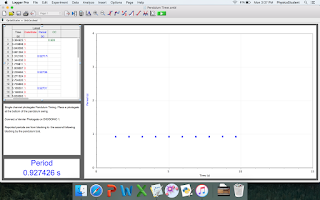Purpose: Derive expressions for the period of various physical pendulums and verify predicted periods by experiment.
Apparatus:
By hanging the ring as well as the triangle on a stand and then placing a photogate near where the rotation is, we can measure the period of oscillation.
Theory:
Parallel axis theorem is used to find the moment of inertia about the pivot point. With the new inertia, it can be used to find the angular acceleration. By the small angle estimation, we can find angular frequency, which is then used in an inverse relationship with period.
Data:
Calculation/Graphs:
Period of Ring
Period of Triangle
Period of Upside Down Triangle
Calculation of Theoretical Period of Ring
Calculation of Theoretical Period of Triangle
Analysis:
The point of pivot of the ring is assumed to be exactly half way between inner and outer radii and it has no impact on the uniformity of the mass distribution. The periods of the oscillating objects tended to decrease due to gravity, which is why the average of the periods is used instead. These pendulums cannot use the same model as a simple pendulum due to the differences in moments of inertia, which can impact everything. The mass of the pivot is negligible because it is very small in comparison to the whole object.
Conclusion:
The errors were all calculated to be less than 1%, showing that the model of parallel axis theorem as well as the small angle estimation are valid. Sources of error may be in the rotating pivot point, as there might be friction or other unaccounted forces.










No comments:
Post a Comment